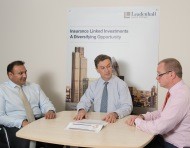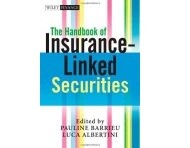Luca Albertini & John Wells

- Classification
- Evolving Investment Opportunities
- Company
- Leadenhall Capital Partners LLP
Leadenhall Capital Partners LLP was established in April 2008 by John Wells and Luca Albertini and approved by the UK Financial Services Authority on 5th November 2008.
John Wells is Leadenhall’s Chairman and has over 30 years of market experience firstly as an investment banker with the NatWest Group (including 5 years in Tokyo) and then from 2000 to 2005 as one of the founders of Swiss Re Financial Products. He graduated from Cambridge University.
Luca Albertini (Chief Executive) has over 20 years of securitisation experience, having worked at Citibank, GE Capital, Credit Suisse First Boston and Swiss Re Capital Markets. Before starting Leadenhall, Luca gained insurance securitisation experience at GE Frankona Re and then Swiss Re Capital Markets. Luca ran Swiss Re’s ILS business in Europe for five years. He is a sought after speaker at ILS conferences due to his unrivalled knowledge of the structural features and investor requirements for ILS transactions and is the co-editor of The Handbook of Insurance Linked Securities (Wiley, July 2009). Luca is a graduate of Bocconi University, Milan

eadenhall Capital Partners LLP offers access to three open-ended dedicated funds (and a number of managed accounts) which give institutional investors access to both life and non-life insurance linked investments. Leadenhall manages two predominantly non-life investment strategies: the Value Fund (purely non-life) and the Diversified Fund (which holds up to 20% in life investments), and one Life only investment strategy through the Life Fund.
The funds offer investors access to pure reinsurance risk through investments which have exposure to property losses from extreme natural catastrophes (major hurricanes and earthquakes) and other insurable risks (e.g. marine risk). Its life strategies provide investors with the opportunity to access returns from the life insurance linked asset class, which mostly focus on mortality and morbidity risks.
Why do we focus on insurance-linked assets?
The founders of Leadenhall were involved at Swiss Re with the Insurance Linked securities from its early days and saw the diversification and low correlation benefits of the asset class for institutional investors. Particularly in today’s low yielding investment market, investors benefit from the attractive returns of the sector, whilst diversifying their risks from the traditional equity and debt capital markets. Our joint venture with Amlin PLC, one of the leading Lloyds of London companies gives us unrivalled access to a wide number of primary insurance companies from which to access risk as well as the CAT bond and Industry Loss Warranty (“ILW”) markets. Our portfolios are constructed using relative value choices across these instruments based on the underlying investment objectives of our investors.
We do not undertake active hedging of insurance tail risk which can be expensive and have built stable returns based on portfolio construction using a large number of relatively small investments which have given us diversification of risk within the portfolio and reduced our exposure to major US wind risk relative to some of our competitors Leadenhall Capital Partners

There are broadly three types of insurance linked asset classes which are currently invested in by capital markets funds:
1.Natural Catastrophes
Peak modelled natural catastrophe risks (such as earthquakes in the US or in Japan, windstorms in Japan, the US and Europe, floods in Europe) are the main opportunity for capital markets investors. Natural catastrophes are “peak” when there is a particularly high concentration of insured exposures in areas potentially exposed to large events. Peak risk areas include Tokyo metropolitan, the North East states in the US, Florida and the Gulf of Mexico, California and Europe. For insurance and reinsurance companies, reinsuring some of their peak exposures above certain levels generates rating and regulatory capital benefits for them, while for investors the demand for coverage from the insurance companies generates attractive returns.
2.Specialty Insurance
Short tail specialty risks (such as terrorism, marine, satellite, aviation, great industrial risks), are attractive to capital markets investors as they maintain attractive risk and returns, but diversify the investors’ exposure to insurance risks away from the peak perils.
3.Life insurance
Mortality risk is a “peak” exposure for insurers and reinsurers on the life insurance side and has been securitized for capital markets investors in the past. Mortality risk is very attractive to investors due to its low volatility, and to the investor’s ability to monitor developments leading to increased risks (such as the spread of a pandemic). For the insurer or the reinsurer the cover generates rating and regulatory capital savings, and therefore is capital efficient.

The key risks include:
1.Event Risk
This is the probability of an event (e.g. a typhoon or an earthquake) occurring in a given location. Whilst nothing can prevent an event from occurring or predict location size or timing of an event, the mitigation strategy is the desired level of portfolio granularity and diversification which limits the loss severity from a large event to the targeted risk limits (so portfolio construction is the mitigation)
2.Underwriting risk
The losses experienced from an event can be amplified by the poor performance of a protection buyer. Where investments have an “indemnity “ trigger ( based on losses of the protection buyer above agreed limits), protection buyers must be analyzed for their own underwriting processes, staffing, distribution channels and claims processing. Understanding each component is a key militant of underwriting risk. This is one of the key reasons for a capital markets investor to partner with a reinsurer as the reinsurers have the manpower to undertake a more thorough due diligence process as part of their (generally) larger exposures to a protection buyer
3.Credit risk associated with collateral
Most insurance linked structures are collateralized. The choice of collateral investment can introduce sources of credit risk. Insurance linked securities and private placement tend to opt for the most conservative collateral types (such as US Treasuries or Treasuries Money Market Funds) to limit the credit risk to the minimum
4.Structuring Risk
Insurance Linked Securities and other investments are structured instruments and as such the structure needs to be analyzed to minimize unintended tax charges, loss amplification, loss of collateral, wordings that introduce risks not agreed to be covered. Mitigation involves a proper analysis of the prospectuses and structural documents by experts in the team. This mitigation has contributed to Leadenhall’s track record of having avoided all losses from cat bond triggers since our inception in 2008.
5.FX, Interest Rate and? Market Risk
Insurance linked investors are exposed to FX and interest risk on some investments which can be hedged as well as to mark to market risk, which is managed via the manager’s experience.

John Wells set up Swiss Re’s capital markets division in 2000. Luca Albertini set up Swiss Re’s European ILS desk, where he was an originator and a structure. In his role he came across a number of fund managers investing in his structured products in the insurance linked space. After 16 years as structurers and as originators, Luca and John believed that investment in Insurance Linked products is very much more about portfolio construction and underwriting than about trading. Luca noticed that his competitors tried to replicate the insurance underwriting model with very little insurance underwriting skills available (and 10% or less than the resources normally available to an underwriter). For this reason Luca and John believed that setting up a fund manager associated with a reinsurer but with an independent investment selection process (as we must look for the interests of our third party investors and not of the shareholders of the reinsurance entity) was a unique business model with great potential and a first mover advantage. To date our business model has been praised by key market players but has not been able to be replicated by others (as all other reinsurance associated fund managers are not fully independent from the reinsurer as the reinsurer ultimately decides on the pay of the fund managers). We therefore believe we have added something of value to what is available in the fund management world, and are very happy with our decision.

Our investment belief is that a fund manager’s task is to fully understand his clients’ investment and then seek to achieve them while minimizing the risk undertaken. What is absolutely critical for us is that the investment manager understands the risk and return objective of his clients and communicates back to the clients the risk taken by them in a fair and transparent way. Our reputation is based on performance, understanding our clients’ objectives maintaining trust through transparent communication. What we would never do is seek to exceed the targeted return by taking excessive risks with our clients’ assets in order to profit from greater performance fees.

The reference book on insurance linked investments is “The Handbook of Insurance Linked Securities” published by Wiley. In saying that we are a bit biased as the book was edited by Luca Albertini with Prof. P. Barrieu (London School of Economics). Another book is “Alternative (re)insurance strategies” published by Risk Books and edited by Morton Lane (where Luca Albertini is a contributor on a chapter about risks in ILS investments). Morton Lane is a competent consultant in the insurance linked world and ensured the contributions were of high standards

Insurance Media: Insurance Insider, Trading risk and Artemis
General media: Financial Times, BBC News and Bloomberg
Other Websites: key event bulletins are published on tropicalstormrisk, AIR Alert, Met Office, USGS, NOAA, JTWC, Perils, PCS, Munich Re NatCatService, Swiss Re Sigma, and the websites of all the major broking firms
Notes:
This article originally appeared on Mar 23, 2015. Any views presented in this article are as of such date and are subject to change.
This article and the information provided therein are not a recommendation to purchase or sell any security, nor are they intended to constitute the marketing of, or a solicitation for investment in, any investment product.
Leadenhall Capital Partners LLP is a London based investment manager wholly focused on investing in insurance linked investments portfolios for institutional investors. Established in 2008, Leadenhall is a joint venture between an international Lloyd's of London underwriter of insurance and reinsurance, the Amlin Group, and a highly experienced management team. Amlin, headquartered in the UK, is a major London market participant with a presence at Lloyd’s of London and offices in key reinsurance hubs such as Bermuda, Zurich and Singapore.
Leadenhall’s team has significant insurance capital markets experience gained at Swiss Re, Aon Benfield Securities & Guy Carpenter, with John Wells, the Chairman, and Luca Albertini, the CEO/CIO having a combined experience of over 55 years in the financial services industry.
Leadenhall Capital Partners offers dedicated funds and managed accounts which give institutional investors access to both life and non-life insurance linked investments; through its non-life strategies Leadenhall offers its investors access to pure reinsurance risk through investments which have exposure to property losses from extreme natural catastrophes (major hurricanes and earthquakes) and other insurable risks (e.g. marine risk). Its life strategies provide investors with the opportunity to access returns from the life insurance linked asset class, which mostly focus on mortality and morbidity risks.
Investors benefit from the attractive returns of the sector, whilst diversifying their risks from the traditional capital markets. A number of instruments, such as cat bonds and private placements of collateralised reinsurance, are used to transfer insurance linked risk to the capital markets; Leadenhall uses all of them to balance liquidity, profitability, diversification and growth.

March 23, 2015
by Investment in Japan

